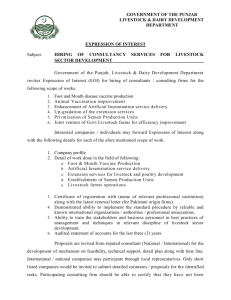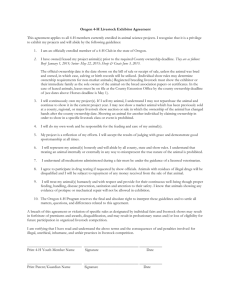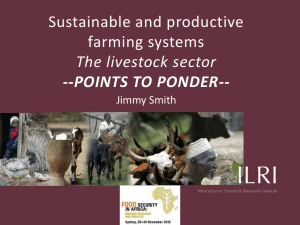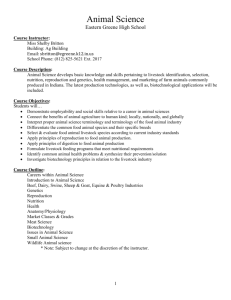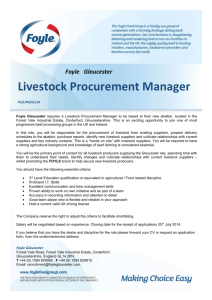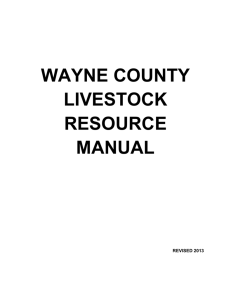See their participatory needs assessment
advertisement
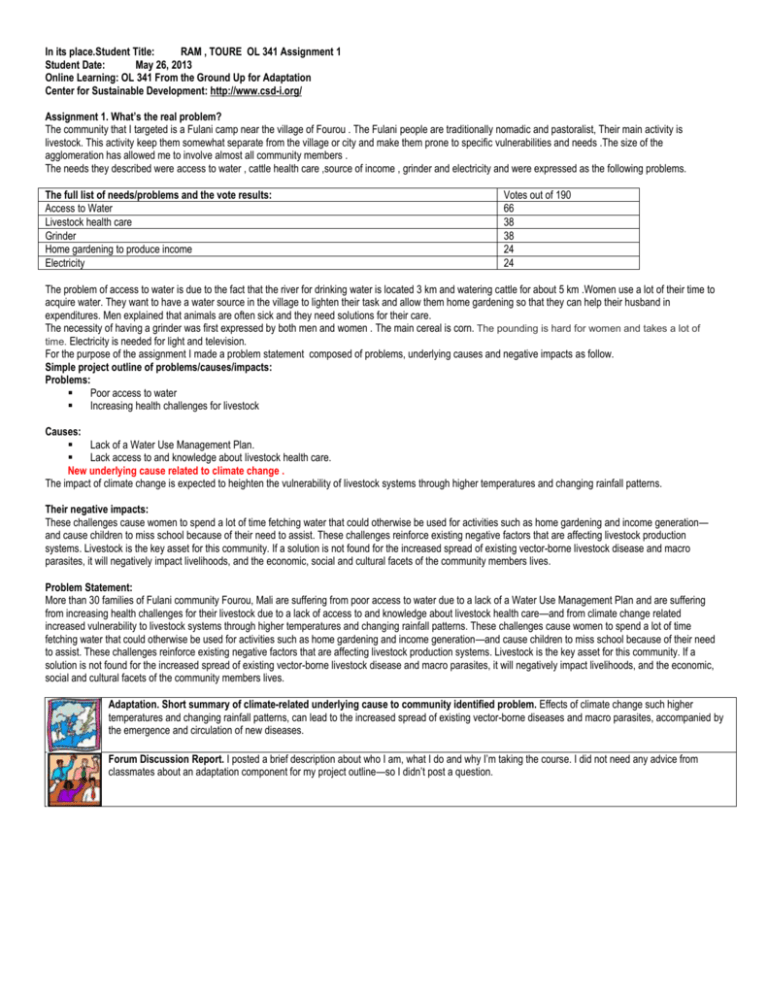
In its place.Student Title: RAM , TOURE OL 341 Assignment 1 Student Date: May 26, 2013 Online Learning: OL 341 From the Ground Up for Adaptation Center for Sustainable Development: http://www.csd-i.org/ Assignment 1. What’s the real problem? The community that I targeted is a Fulani camp near the village of Fourou . The Fulani people are traditionally nomadic and pastoralist, Their main activity is livestock. This activity keep them somewhat separate from the village or city and make them prone to specific vulnerabilities and needs .The size of the agglomeration has allowed me to involve almost all community members . The needs they described were access to water , cattle health care ,source of income , grinder and electricity and were expressed as the following problems. The full list of needs/problems and the vote results: Access to Water Livestock health care Grinder Home gardening to produce income Electricity Votes out of 190 66 38 38 24 24 The problem of access to water is due to the fact that the river for drinking water is located 3 km and watering cattle for about 5 km .Women use a lot of their time to acquire water. They want to have a water source in the village to lighten their task and allow them home gardening so that they can help their husband in expenditures. Men explained that animals are often sick and they need solutions for their care. The necessity of having a grinder was first expressed by both men and women . The main cereal is corn. The pounding is hard for women and takes a lot of time. Electricity is needed for light and television. For the purpose of the assignment I made a problem statement composed of problems, underlying causes and negative impacts as follow. Simple project outline of problems/causes/impacts: Problems: Poor access to water Increasing health challenges for livestock Causes: Lack of a Water Use Management Plan. Lack access to and knowledge about livestock health care. New underlying cause related to climate change . The impact of climate change is expected to heighten the vulnerability of livestock systems through higher temperatures and changing rainfall patterns. Their negative impacts: These challenges cause women to spend a lot of time fetching water that could otherwise be used for activities such as home gardening and income generation— and cause children to miss school because of their need to assist. These challenges reinforce existing negative factors that are affecting livestock production systems. Livestock is the key asset for this community. If a solution is not found for the increased spread of existing vector-borne livestock disease and macro parasites, it will negatively impact livelihoods, and the economic, social and cultural facets of the community members lives. Problem Statement: More than 30 families of Fulani community Fourou, Mali are suffering from poor access to water due to a lack of a Water Use Management Plan and are suffering from increasing health challenges for their livestock due to a lack of access to and knowledge about livestock health care—and from climate change related increased vulnerability to livestock systems through higher temperatures and changing rainfall patterns. These challenges cause women to spend a lot of time fetching water that could otherwise be used for activities such as home gardening and income generation—and cause children to miss school because of their need to assist. These challenges reinforce existing negative factors that are affecting livestock production systems. Livestock is the key asset for this community. If a solution is not found for the increased spread of existing vector-borne livestock disease and macro parasites, it will negatively impact livelihoods, and the economic, social and cultural facets of the community members lives. Adaptation. Short summary of climate-related underlying cause to community identified problem. Effects of climate change such higher temperatures and changing rainfall patterns, can lead to the increased spread of existing vector-borne diseases and macro parasites, accompanied by the emergence and circulation of new diseases. Forum Discussion Report. I posted a brief description about who I am, what I do and why I’m taking the course. I did not need any advice from classmates about an adaptation component for my project outline—so I didn’t post a question. Good afternoon team Mali, Very nice to meet you properly. I hope you are looking forward to a wonderful week. Excellent job on your first assignment. Gold stars all around! Please note: this e-mail note is included in the attachment called "assignment one with comments" in order to make it easier for you to read, copy and paste ideas. Although you did a very good job I'm going to make a couple of suggestions—I hope that they are helpful. Problem Definition: You actually did a very good job of problem identification and links to their underlying causes. I'm going to suggest modifying the wording of the two problems without changing their meaning. Underlying Causes: I'm moving the climate change phrase "reinforce existing factors" down into negative impacts. And then move what you said down below about higher temperatures and changing rainfall patterns into its place. I'm also going to suggest that we change the underlying cause about location to say something more like "lack of a water use management plan" because this will be an umbrella plan which can take into account their location and also analyze ways of getting water to the community members. So now by looking at the rearranged problems and causes you have two distinct problems that are directly linked to three distinct causes. Negative Impact Statement: The negative impact statement was well done but just needed cleaning up a little bit. So, I clipped a few things from here and there in the body of your work that are direct results of the problems—and pasted them in. Problem Statement: The problem statement is meant to be simply the logical accumulation of the problems, the underlying causes and the negative impact—simply collapsing the outline as it is written into a single short paragraph. So I copied the problem, causes, and negative impact statement, and pasted them into the problem statement so that they were all absolutely parallel and equal to each other. Hints for Assignment 2: I’m going to paste in some solutions below that past students have used successfully. Feel free to use them, modify them or develop your own solutions instead. So, for example, you could include or modify something like the following program outline in your assignment two: [Problem 1]. Poor access to water. Water Use Management Plan [Solution to underlying causes: Lack of Water Use Management Plan.] [Activity 1]. Community-based workshop and survey with community members to identify their knowledge of water use. [Activity 2]. Consultation with water management expert to develop a participatory process and training program [Activity 3]. Facilitate the Organization of a community based Water Use Management Committee [Activity 4]. Community workshop on participatory mapping of water resources and uses (consciousness raising) [Activity 5]. Prioritize water springs, rivulets, ravines and man-made waterways for protection/restoration [Activity 6]. Investigate water sourcing alternatives for the community [Activity 7]. Committee participatory workshop on developing a community based Water Use Management Plan [Activity 8]: Investigate and develop an installation and maintenance program for appropriate water sourcing alternatives [Activity 9]: Data collection to identify scientific baseline data and facilitate the organization of a community based Monitoring and Evaluation Committee [Problem 2]. Increasing health challenges for livestock. Animal Husbandry Program [Solution to underlying causes: Lack access to and knowledge about livestock health care stock; climate change related challenges to livestock health.] [Activity 1]: Facilitate the creation of a Livestock of Association. [Activity 2]: Community-based workshop and survey with community members to identify their knowledge of animal husbandry. [Activity 3]. Consultation with pastoral animal husbandry expert to develop a participatory process and training program [Activity 4]: A training program with a view to increase the training level of pastoralists in improving their know-how and skills in herd size, health, hygiene, nutrition, and proper care [Activity 5]. Periodic training sessions and 12 months of follow-up activities with pastoralists Please look at the attached student program example sheet too. There might be program ideas that better fit your specific context. Moving forward to Assignment 2. If this is acceptable to you, please move forward to assignment two. If this is not acceptable, that is fine, simply send me your amended Assignment One marked “Final”. In moving onto Assignment Two, please follow my example as your template and don’t change this final outline from Assignment One. This is strictly copy and paste from Assignment 1 to Assignment 2. I also need to make sure that the three of you are participating in the forum, Facebook, and the Development Community—and I don't see mention of this at the bottom of this assignment. NB: I copy/pasted this information from a number of sources so fonts and formatting vary--and there may be typos too. It will save me a ton of time if you can just fix/reformat the things you like to be equal to each other in Assignment 2. Thank you! Thank you for the good job that you did—it certainly makes my job more enjoyable. Sincerely, Tim


